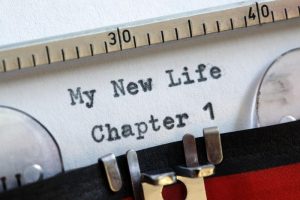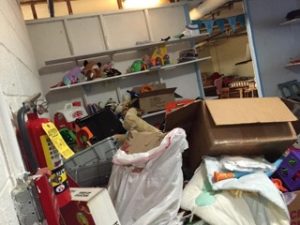 So much of getting organized is about building new habits. To maintain those habits, you have to exercise your organizing muscles regularly. Below are a few exercises to help you get into shape.
So much of getting organized is about building new habits. To maintain those habits, you have to exercise your organizing muscles regularly. Below are a few exercises to help you get into shape.
Remember, one of the fastest ways to feel lighter is to exercise your organizing muscles by shedding pounds of clutter. Happy New Year!
Click on the above title to learn more about the featured author.
People often wonder about the possible value of items they have accumulated over many years. These items are often viewed as “treasures” which may have significant resale value. Finding the “treasures” among their possessions often surfaces when:
 Many of the items accumulated may not have been purchased by the current owner including inherited items, gifts received, or collections of a spouse who has passed away.
Many of the items accumulated may not have been purchased by the current owner including inherited items, gifts received, or collections of a spouse who has passed away.
People often have a sense of the value of some of their valuables. However, in many cases the values are from past information or are based on a retail price that does not represent current resale value.
Many people research and try their hand at determining resale values. The internet is the most common resource used. There is a great deal of information available on the internet, so much so, that it can become overwhelming. However, it is possible to get a sense of what to expect in the current market. A few resources which are helpful, free, and fairly easy to use are EBay, Live Auctioneers, and Invaluable. Each of these resources provide a history of the selling price of items which have been offered through their sites. They provide the sales history with no charge once you have registered (registration is free). When researching items, it is important to look at the selling price results of the same or similar items. Using the asking price is not reliable because the seller can ask any price they would like for an item. Therefore, it is the selling price which provides a more accurate measure of resale value.
Often, another challenge is properly identifying the item to be valued. There are reproductions or copies which can be difficult to differentiate from originals. There are maker marks and signatures which are difficult to find and read. I have had clients get extremely excited about an item they saw on Antiques Road Show that was worth many thousand of dollars and looked just like the one they own. In most cases, there are subtle differences and their item is of much less value.
It is helpful to have the help of a trained eye. There are professional resources available to help identify the value of potential treasures:
A common question I receive relates to collectible plates and other collectible items which have been purchased on late night television throughout the decades. In most cases, there is little or no value to these items. When there are many of something sold to many collectors, the value does not often increase. The resale market is driven by supply and demand. When there is a large supply of collectible items made for collecting, there is rarely enough demand to make them valuable.
 Finding treasures is an adventure which is rewarding and disappointing at times. Enjoy the adventure and I wish you good luck as you treasure hunt.
Finding treasures is an adventure which is rewarding and disappointing at times. Enjoy the adventure and I wish you good luck as you treasure hunt.

As a professional organizer, I help people deal with their stuff. Some clients hire me because they have too much stuff. Others because they don’t know how to store their stuff. And still others because they want to learn how to eliminate useless stuff from their lives. I don’t think you’re shocked to hear that I’ve never had to help a client feel less overwhelmed from owning too many cars or dishwashers. People are incredibly thoughtful when making large purchases. We keep in mind all of the costs involved and make sure the new item fills a need in our life and fits our lifestyle.
When we are considering spending a significant amount of money on a car, technology or household appliance, we examine a few key criteria:
• Will it do what I need it to do?
• Will it stay current long enough to warrant the investment?
• Will it integrate with what I already own?
• Is it the right size for the space?
• Can I handle it properly (car, computer, pet)?
• Is required service going to be easy or a hassle?
• Can I afford the maintenance?
These are all reasonable questions.
So why does sanity and sensibility go out the window when we purchase small ticket items? We don’t even think about need for items under a certain price point. We forget that the financial investment we’ll have to make is over the LIFE of the item, not just at the point of purchase. And we don’t look at the price on our life.
Clothes, school supplies, toiletries, kitchen gadgets and sports equipment are just some of the categories where people ignore that there are costs beyond the price at the register. And when someone makes enough poor purchases, there are lots of unseen, down-the-road prices to pay.
The cost is to our pocketbooks, living spaces, psyches and planet. We would do well to ask of each small item the same we ask — dare I say, DEMAND — of significant investments before we look at the selling price:
• Will this answer a real need in my life?
• Can I afford to store and maintain it?
• Do I have the time and mental space to learn how to enjoy it?
On this Cyber Monday, and throughout the holiday gift-giving season, it is even more important to consider, not just for yourself but for your friends and family, is this item worth the price? And remember, not every gift has to be a THING.
Click on the title above to learn more about the featured author.
 At different times in life, one finds oneself faced with the task of making life-altering changes to pave the way for new possibilities. As an organizer, I have the privilege of being with clients as they journey toward a new life and new possibilities. An inspiring vision is their guiding light and a tool box of new questions is their rudder, navigating them toward their goals and aspirations.
At different times in life, one finds oneself faced with the task of making life-altering changes to pave the way for new possibilities. As an organizer, I have the privilege of being with clients as they journey toward a new life and new possibilities. An inspiring vision is their guiding light and a tool box of new questions is their rudder, navigating them toward their goals and aspirations.
Inspired by speakers Joshua Millbum & Ryan Nicodemus, “The Minimalists”, and Marilee Adams’ book “Change Your Questions, Change Your Life”, I have been exploring the notion that one could change one’s life, its patterns, habits and outcomes simply by changing the questions we ask ourselves. Can it be that simple?
When you think about it, questions illuminate:
Questions shed light on, and offer a deeper understanding of, the choices we make and why. Dr. Adams says, “Our behavior follows our questions” and “new questions shape and direct new behaviors.”
When I began questioning myself about the “stuff” in my life, I noticed there was an innate, underlying meaning I had given to each item that was affecting my decision-making process. During one of my closet purging events, I began to hear the meanings I had assigned each item. Slowing down and listening carefully, I could hear myself arguing for each item and justifying why things should stay, saying:
In other areas of my home and my clients’ homes, I see items being kept for fear that the memory will be lost forever if not saved. Text books, research papers and thesis notes are symbols and trophies of accomplishments and successes representing a former self and held for posterity. Items that have recognized value are held to say something about us even though we don’t like, appreciate or use them.
Why do we give so much meaning to our stuff? Who knows? What I’ve noticed is that when the meaning we give to items remains unexamined and undistinguished, the more likely they are to stay on our shelves versus leave to create space in our lives. Asking rigorous questions and listening intently for the meaning we give to items offer us new interpretations and perspectives, and the freedom to let go.
Questions I like to ask are:
Last week I spoke to someone who was facing a plumbing crisis but needed to declutter large areas before the repair work could be done. Questioning himself, he began to uncover that he was, as he called himself, “Mr. Someday.” Things he acquired and saved were for someday. When he saw something, his question was, “How can I use this, someday?” It’s not such a bad question once in a while, except what he was now facing was all the “someday” projects that never happened and instead were impeding the plumbing repairs. Armed with both a new vision to say goodbye to “Mr. Someday” and new questions to shape his actions moving forward, he was off and running to change his lifestyle and life.
How might life be better if we owned less stuff?
The Minimalists say, “Life can be richer with less stuff.” Dr. Adams’ asks, “What new questions can take us there?”
If letting go to reduce the amount of stuff in your life is your mission and you need help along the way changing your questions to change your life, find an organizer in your area. We would love to support you.
Click on the title above to learn more about the featured author.
 “Eye of newt, and toe of frog,
wool of bat, and tongue of dog,
adder’s fork, and blind-worm’s sting,
lizard’s leg, and howlet’s wing…” ~William Shakespeare, Macbeth
“Eye of newt, and toe of frog,
wool of bat, and tongue of dog,
adder’s fork, and blind-worm’s sting,
lizard’s leg, and howlet’s wing…” ~William Shakespeare, Macbeth
Reaching into the cupboard for canned pumpkin, you come upon what appears to be a rotting bag of potatoes you’d forgotten that you bought a couple of months ago.
You go down to the basement to pull out your holiday décor and realize it will take days to even get close to the area where it is stored – the boxes you can reach have been chewed into by…something.
You look under a bathroom sink for the ointment you haven’t used since last year’s blister you got while raking and you discover what must be a leaking pipe (and a mass of soggy toiletries).
Just because you have not actively used a storage area for some time, doesn’t mean that it has remained unchanged in your absence. Storage spaces like basements, spare rooms, closets and cabinets can be easily ignored when organizing or cleaning. The items they contain do not present the issue of “visible” clutter. The door is closed and what is stored is not in anyone’s way. Besides, the everyday mass of new paper, gadgets and gizmos coming in that crowd our countertops are enough of a challenge. Who has the time to deal with what’s already stored? Right?
Well, unfortunately, what is out of sight and out of mind is not necessarily out of play in the functioning of our homes and lives.
We want to be able to use the storage that we have in order to be able to put away supplies, seasonal items, sentimental memorabilia and the like, so as to keep them from impinging on our daily living. However, if we continue to shove new items in, we can end up pushing older items back, back, back into the dark recesses known only to the Boogieman. Therefore, an occasional survey of storage spaces can keep them functional and friendly. And, although I doubt you’ll need worry about coming across any ingredients in Shakespeare’s brew, you may want to be prepared for the unexpected when venturing to take-on one of these areas.
If you’ve seen signs of bugs or rodents, consider bringing in an exterminator first and holding off for a week or two on the organizing. If there’s a leak that you cannot find or fix yourself, call a plumber sooner rather than later. Unaddressed leaks and critters can do damage to your health and your home, not to mention your wallet. Take care of them before they turn into a caldron full of trouble.
Let the witches and goblins that ring your bell for candy be your only scary surprise this fall season!
Click on the title above to learn more about the featured author.
 What happens if you love to shop BUT hate to organize? Or you don’t have the time or energy to deal with what you buy?
What happens if you love to shop BUT hate to organize? Or you don’t have the time or energy to deal with what you buy?
All those “great deals” become clutter when you bring things into the home and either don’t have a place to put them right away or haven’t purged things to make room for them. What happens most of the time? The items stay hidden in bags that pile up. Then there’s a problem.
Too much stuff, with no place to put it, leads to clutter and chaos which do not allow the stress-free, organized home you desire.
Before you buy something, ask yourself these questions:
Remember—if a deal seems too good to pass up, but you don’t need the item, you need to put it somewhere if you bring it home. The floor does not count so no bags should be piled up on the floor.
Before buying more things, ask yourself the above questions. You’ll learn over time that the best way to stop clutter is before it enters your home.
Click on the title above to learn more about the featured author.